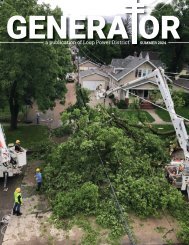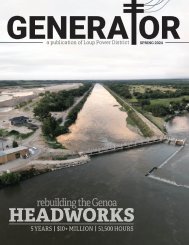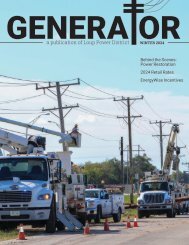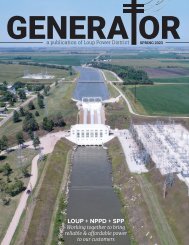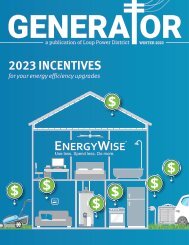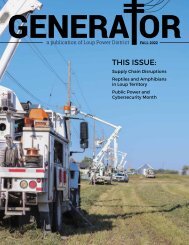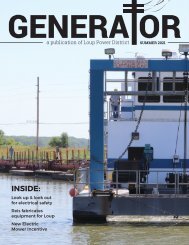Generator — Winter 2021
In this issue: Rates unchanged for 2021; EnergyWise Program Update; Jim Schindel retires after 44 years of service.
In this issue: Rates unchanged for 2021; EnergyWise Program Update; Jim Schindel retires after 44 years of service.
Create successful ePaper yourself
Turn your PDF publications into a flip-book with our unique Google optimized e-Paper software.
GENERA OR<br />
a publication of Loup Power District WINTER <strong>2021</strong><br />
INSIDE:<br />
No change to <strong>2021</strong> retail rates<br />
EnergyWiseSM<br />
incentives update<br />
Schindel retires after 44 years
BOARD OF DIRECTORS<br />
Chris Langemeier<br />
Chairman<br />
Ross Knott<br />
First Vice Chairman<br />
Alan Drozd<br />
Second Vice Chairman<br />
Steve Heesacker<br />
Secretary<br />
Dick Tooley<br />
Treasurer<br />
Rich Aerni<br />
Robert Cerv<br />
Jim Donoghue<br />
Mike Fleming<br />
Larry Zach<br />
HOW DO WE SET<br />
ELECTRICITY RATES?<br />
Loup Power District identifies electricity rates based on cost of service<br />
while keeping our customers and our communities front and center. As a<br />
not-for-profit company, Loup does not answer to remote shareholders and<br />
is not driven by a profit motive. Revenues are invested right back into the<br />
company and communities.<br />
EXECUTIVE STAFF<br />
Neal Suess<br />
President/CEO<br />
Walt Williams<br />
Vice President,<br />
Accounting & Finance/CFO<br />
Todd Duren<br />
Vice President,<br />
Corporate Services<br />
Korey Hobza<br />
Vice President, Engineering<br />
Dan Hellbusch<br />
Vice President, Operations<br />
The Loup <strong>Generator</strong> is<br />
published quarterly<br />
as a service for Loup<br />
employees, families,<br />
friends and associates.<br />
For feedback, story ideas<br />
and submissions, contact:<br />
Stacy Wemhoff<br />
Communications Coordinator<br />
402-562-5711<br />
swemhoff@loup.com<br />
ADD UP ALL THE COSTS. Loup conducts a cost-of-service study to<br />
determine the revenue requirement <strong>—</strong> how much revenue is required<br />
to maintain financial stability. The costs are separated into three areas:<br />
power supply and transmission, distribution, and customers.<br />
DIVIDE REVENUE REQUIREMENTS by customer class <strong>—</strong> commercial,<br />
industrial, residential. The cost-of-service study identifies how and when<br />
each class uses energy, and how the utility incurs costs from each class.<br />
The study identifies the amount to recover through customer, demand,<br />
and energy charges for each customer class, and how costs vary by time of<br />
day or season. This amount is then compared with the rates for each class.<br />
FACTOR a rate adjustment strategy into a financial plan. The plan takes input<br />
from management and the Board of Directors and lays out a strategy for<br />
how rates should be implemented in the future. The plan ensures adequate<br />
revenues are recovered for each class of customer and explains how each<br />
rate component (customer, energy, demand) should vary over time.<br />
BALANCE the recommended rates with the governing body’s input and<br />
community objectives. Loup’s managers present the rate study to the Board<br />
of Directors. The Board decides whether the proposed rate structure meets<br />
the needs of the community and the utility’s revenue requirements.<br />
FINAL RATE. The newly set rates go into effect on<br />
customers’ monthly bills. Loup’s residential rates have<br />
not changed since 2018.<br />
2 | GENERATOR<br />
COVER: Clarkson Local Superintendent Josh Siebrandt puts rubber coverups on the primary power lines<br />
during a house move in late September to protect the house and movers from incidental contact.
pReSIDeNT’S MessAGe<br />
Loup’s retail rates among<br />
lowest in state and nation<br />
For the fourth consecutive year, the District is<br />
planning no change to retail rates. This really<br />
is a testament to how hard District employees<br />
and the District’s Board of Directors work to<br />
manage expenses.<br />
The District has seen a number of events that<br />
could have negatively affected our retail rates<br />
over the past several years: the new hydroelectric<br />
license in 2017 (which reduced the amount<br />
of generation produced from the hydroelectric<br />
system), the mid-March 2019 storm event that<br />
created havoc on the canal system (as well<br />
as other areas of the District), and finally the<br />
effects of the COVID-19 pandemic in 2020.<br />
Each of these events has affected the District<br />
and our customers in different ways, but in<br />
each case, the District has managed to keep<br />
our overall rate levels unchanged for our<br />
customers.<br />
A lot of this has to do with the interaction the<br />
District has with our power supplier, Nebraska<br />
Public Power District (NPPD). Almost all of<br />
the energy used by the District’s customers<br />
is purchased from NPPD. Approximately<br />
70 percent of the District’s annual expense<br />
budget is purchased power costs from NPPD.<br />
Therefore, it is important that the District<br />
works closely with NPPD to understand how<br />
its production costs are being managed.<br />
We are fortunate that NPPD’s headquarters are<br />
located in Columbus. District employees have<br />
daily interaction with NPPD, and we see NPPD<br />
employees about town as we perform our daily<br />
activities. Having this friendly interaction<br />
makes it easier to deal with NPPD one-on-one<br />
when there are business concerns.<br />
Knowing how NPPD’s costs are derived is<br />
important. Power supply is a complex activity.<br />
NPPD’s management has been very active<br />
in helping wholesale customers understand<br />
how costs are changing and what we can do to<br />
impact cost changes for NPPD.<br />
District management and the Board of<br />
Directors have worked hard to understand this<br />
complexity and to help manage this to control<br />
District costs for our customers.<br />
As we continue to move forward in 2020<br />
and <strong>2021</strong>, the overall effects of the COVID-19<br />
pandemic will continue to affect the expenses<br />
of the District. How this may impact retail<br />
rates beyond <strong>2021</strong> is yet to be seen, but rest<br />
assured, the District is working hard to keep<br />
retail rates as low as possible.<br />
The District’s Board of Directors is very proud<br />
of this. We will strive to continue this ranking<br />
in the future.<br />
Until next time, be happy and stay safe!<br />
NEAL SUESS<br />
President/CEO<br />
Based upon the latest American Public<br />
Power Association survey, the District<br />
is in the lowest tenth percentile<br />
for retail rates both<br />
statewide and nationally.<br />
WINTER 2020 | 3
No change to <strong>2021</strong> retail rates<br />
Retail rates for Loup Power District’s<br />
retail customers will remain the same in<br />
<strong>2021</strong> for the fourth consecutive year.<br />
The Loup Power District Board of Directors<br />
reviewed current rate levels as well<br />
as budgeted revenue and expenses at<br />
the November and December board<br />
meetings. This also included a review of<br />
a retail cost of service study performed<br />
by management.<br />
As part of this review, the board<br />
analyzed the purchased power costs<br />
from Nebraska Public Power District<br />
(NPPD), the District’s wholesale power<br />
supplier.<br />
NPPD’s overall costs and rates to Loup<br />
did not change for 2020, even though<br />
some costs did change between the<br />
summer and winter season. Therefore,<br />
the District’s Board of Directors felt<br />
there was no need to change retail rates.<br />
“Prior to the recent run of consistent<br />
retail rates, the District has reacted<br />
to changes in wholesale power and<br />
operational costs by making changes<br />
to the retail rates,” said Jim Donoghue,<br />
chairman of Loup’s Rates Committee.<br />
“However, the District Board has<br />
worked with management to keep retail<br />
rate levels steady, even given the effects<br />
of the damages from the 2019 storm to<br />
the District’s hydroelectric system and<br />
the impact of the COVID-19 pandemic<br />
on District customers in 2020.”<br />
Donoghue added that Loup’s board<br />
has implemented a long-term strategy<br />
to maintain its reserve margin at<br />
reasonable levels and keep retail rates<br />
competitive.<br />
Loup Power District’s overall rates are<br />
24.8 percent below the national average<br />
and 11.2 percent below the Nebraska<br />
average based on data from a 2019<br />
American Public Power Association<br />
survey.<br />
“Loup’s rates remain among the lowest<br />
in Nebraska and the Nation,” said Loup<br />
Board Chairman Chris Langemeier.<br />
Overall, Loup Power District’s rates<br />
are in the lowest tenth percentile both<br />
statewide and nationally.<br />
Energy or kilowatt-hour (kWh) usage<br />
is always the determining factor in a<br />
customer’s bill.<br />
Customers in all rate classifications<br />
continue to have opportunities to<br />
reduce their costs by taking advantage<br />
of numerous programs offered by the<br />
District.<br />
These programs include energy incentives<br />
and home energy audits.<br />
For more information on the District’s<br />
retail rates and energy-saving<br />
programs, visit loup.com.<br />
Loup’s retail rates<br />
are 24.8% below<br />
the national average<br />
and 11.2% below<br />
Nebraska’s average<br />
For more information on the District’s retail rates and energy-saving programs,<br />
visit the District’s website at www.loup.com.<br />
4 | GENERATOR
Heat pump water heaters offer cost-saving benefits<br />
ENERGY STAR certified heat pump water<br />
heaters (HPWHs) promise huge energy savings.<br />
A SMART INVESTMENT<br />
While a certified HPWH costs more upfront,<br />
the savings will pay back the difference in two<br />
years for a household of four.<br />
BIG SAVINGS<br />
ENERGY STAR certified HPWHs can save<br />
a household of four approximately $350 per<br />
year on its electric bills compared to a standard<br />
electric water heater.<br />
This adds up to $3,750 over the HPWH’s<br />
lifetime. Larger families that typically use more<br />
hot water will save even more.<br />
PROTECT THE ENVIRONMENT<br />
If all residential electric water heaters less<br />
than 55 gallons sold in the United States were<br />
ENERGY STAR certified HPWHs, the energy<br />
cost savings would grow to almost $12 billion<br />
each year, and 140 billion pounds of annual<br />
greenhouse gas emissions would be prevented<br />
<strong>—</strong> equivalent to the emissions from more than<br />
13 million vehicles.<br />
SAVINGS & PAYBACKS FOR ENERGY STAR HEAT PUMP WATER HEATERS<br />
Household Size Annual kWh Savings Annual $ Savings Payback (years) Lifetime Savings<br />
2 1,350 $170 4.8 $1,370<br />
3 2,020 $250 3.2 $2,450<br />
4 2,690 $330 2.4 $3,530<br />
Assumes: $0.124/kWh; Incremental Cost = $800; 13-year lifespan<br />
Source: U.S. Environmental Protection Agency, ENERGY STAR program<br />
WATER HEATER RED FLAGS<br />
Sometimes water heaters can be working<br />
fine and then fail without warning. Most<br />
times, though, there are early signs that<br />
your water heater may need help. Here<br />
are some common red flags for possible<br />
water heater failure:<br />
• VISIBLE CORROSION – Corrosion is a<br />
sign that the water heater is breaking<br />
down.<br />
• WATER LEAKS – Leaks from any<br />
joints, seals, or seams is usually an<br />
indication of a problem.<br />
• RUST IN YOUR WATER – This is<br />
usually a sign that the interior of the<br />
water heating system is corroding and<br />
breaking down.<br />
• LOW HOT WATER – Aging and poor<br />
maintenance can cause sediment to<br />
build up inside the tank in a way that<br />
reduces capacity.<br />
• RUMBLING NOISES – Water heaters<br />
are designed to operate consistently,<br />
quietly, and reliably.<br />
WINTER 2020 | 5
are you<br />
Check out these energy-saving incentives!<br />
Smart Thermostat Program<br />
According to a Nebraska energy burden study,<br />
the average Nebraska household spends more<br />
than $2,400 on the energy needed to run their<br />
home.<br />
What if you could reduce your heating and<br />
cooling needs by up to ten percent while<br />
helping to automate your home?<br />
If you have a home Wi-Fi connection and a<br />
central air-conditioning or heat pump system,<br />
you may qualify for an incentive of up to $100 for a<br />
qualifying smart thermostat.<br />
Smart thermostat technology is most beneficial for<br />
households that have extended periods during the day when no one is<br />
home or turn their thermostat down during bedtime hours. It is also a great<br />
option for homes that have irregular occupancy through the week, month<br />
or year.<br />
SYSTEM TYPE<br />
INCENTIVE<br />
Primarily Electric Heat (Professionally Installed) $100<br />
Primarily Electric Heat (Customer Installed) $75<br />
Primarily Fossil-Fuel Heat (Professionally Installed) $50<br />
Primarily Fossil-Fuel Heat (Customer Installed) $25<br />
Attic Insulation<br />
Residential customers who have 6" or<br />
less of attic insulation and electric heating<br />
systems are eligible for an incentive of 15¢<br />
per square foot if they add at least 6", or an<br />
additional R-19, of insulation to their attic<br />
space.<br />
The maximum incentive amount is $300<br />
per dwelling.<br />
Variable Frequency Drives<br />
Commercial and industrial customers can<br />
receive an incentive for installing variable<br />
frequency drives (VFDs) on centrifugal fans<br />
and pumps.<br />
The incentive is $30 per horsepower for<br />
VFDs from 1 to 200 horsepower, operating<br />
a minimum of 2,000 hours annually.<br />
Custom Ag Program<br />
Incentives are available for ag technologies<br />
not covered under other programs upon<br />
review and approval.<br />
Agricultural Efficiency<br />
Customers can receive reimbursement for<br />
installing electric heating mats in their hog<br />
farrowing operations. Incentives range from<br />
$40 to $80 per mat.<br />
Irrigation Efficiency<br />
Customers can receive<br />
reimbursement for a pumping<br />
system efficiency test, installing a<br />
variable frequency drive on corner pivot<br />
systems, replacing sprinkler heads, and<br />
for improvements leading to demand<br />
reductions.<br />
Eligible projects include pressure<br />
regulator replacement, pump<br />
refurbishment and more.<br />
6 | GENERATOR
High Efficiency Heat Pumps<br />
Option 1: Direct incentive<br />
SYSTEM TYPE CRITERIA INCENTIVE<br />
Ductless Mini-Split 15+ SEER, 12.5 EER, 8.5 HSPF $400<br />
Ductless Mini-Split Variable Capacity (inverter driven) $600<br />
Air Source 15-15.9 SEER, 12.5 EER, 8.5 HSPF $400<br />
Air Source<br />
16-17.9 SEER, 12.5 EER,<br />
8.5 HSPF<br />
$800<br />
Air Source 18+ SEER, 12.5 EER, 8.5 HSPF $1,200<br />
Air Source Variable Capacity $1,200<br />
Ductless Mini Splits<br />
(Multi Heads, 3 ton or greater)<br />
Geothermal <strong>—</strong> water-to-air<br />
or water-to-water<br />
{1 or 2 stages)<br />
Geothermal <strong>—</strong> water-to-air<br />
or water-to-water<br />
(Variable capacity)<br />
Option 2: Low Interest Loan Program<br />
Variable Capacity (inverter driven) $1,200<br />
Any EER $2,400<br />
35+ EER, 5.0+ COP in GLHP -<br />
partial load column of AHRI<br />
or Energy Star certificate<br />
$3,300<br />
Through a partnership with the Nebraska Energy Office and approximately 600<br />
financial institutions throughout the state, you can finance your new heat pump<br />
system at a low interest rate.<br />
Customers cannot proceed with the installation until the Nebraska Energy Office<br />
has processed the loan paperwork; this can take as many as 10 business days.<br />
Homes built within the last five years are not eligible for the low interest loan<br />
(but they are eligible for the incentive).<br />
Heat Pump Water Heater<br />
SYSTEM TYPE CRITERIA INCENTIVE<br />
Air Source Heat Pump Water Heater EF > 1.9 $400<br />
Water or Ground Source<br />
Heat Pump Water Heater<br />
COP > 2.8 $650<br />
Electric Vehicle<br />
& Charging Station<br />
• $4,000 for the purchase of a new<br />
electric vehicle + $500 for installation<br />
of a residential ChargePoint 32-amp,<br />
Wi-Fi-enabled vehicle charging station.<br />
• Up to $400 for in-home pre-wiring for<br />
future installation of an electric vehicle<br />
charging station.<br />
• Commercial Conduit <strong>—</strong> 100%<br />
reimbursement incentive (maximum<br />
of $1,000) for new commercial<br />
construction for the installation of<br />
conduit to be used for a future public<br />
electric vehicle charging station.<br />
• Commercial Charger <strong>—</strong> 50%<br />
reimbursement incentive for eligible<br />
costs for the installation of an<br />
electric vehicle<br />
public<br />
charging<br />
station.<br />
Cooling System Tune Up<br />
Residential customers are eligible for<br />
a $30 yearly incentive when they have<br />
their cooling system tuned up by an<br />
HVAC contractor.<br />
HVAC System<br />
Optimization<br />
Incentives are provided to commercial<br />
(and industrial) customers for improving<br />
the efficiency of their existing heating,<br />
cooling, and ventilating systems.<br />
Prescriptive<br />
& Custom Lighting<br />
LED lighting incentives are provided for<br />
commercial and industrial customers via a<br />
prescriptive program (an incentive based<br />
on a table for predetermined fixture or<br />
lamp replacements) and a custom incentive<br />
program for lighting systems not offered in<br />
the prescriptive program.<br />
Industrial Process Incentive<br />
Incentives are provided to industrial customers for<br />
improving the efficiency of their processes.<br />
Commercial HVAC<br />
Incentives are provided to commercial (and industrial)<br />
customers for installing high-efficiency HVAC equipment<br />
via a prescriptive program where the incentive is calculated<br />
based on the specific efficiency improvement.<br />
Additional program details are available at loup.com<br />
or by calling Greg Badstieber at 402-564-3171.<br />
WINTER 2020 | 7
Schindel retires<br />
after 44 years<br />
“<br />
I've never thought of<br />
doing anything else.<br />
”<br />
Miles and miles of rebuilt transmission<br />
lines.<br />
That’s what Jim Schindel thinks of as he<br />
reflects on his 44-year career at Loup Power<br />
District.<br />
“We basically built from the Dodge County<br />
line to two miles west of the Boone County<br />
line along Highway 91,” he said. “I was either<br />
in charge of or helped with over 120 miles of<br />
transmission line.”<br />
He was also involved in transmission line<br />
projects near Columbus, Fullerton, Belgrade,<br />
Lindsay, and Genoa.<br />
The feeling of accomplishment was the<br />
same after each project, despite all the miles<br />
and years.<br />
“You see that big pile of poles and all the<br />
reels and wire. All the materials laying there,”<br />
Schindel said. “Five or six months later, you<br />
look out and it’s all in the air and done. You<br />
can see what you did.”<br />
Schindel’s introduction to the utility line<br />
field happened shortly after his graduation<br />
from high school in Hinton, Iowa, in 1974.<br />
He was working at a factory at the time and<br />
talked to a friend who was studying utility<br />
line at Northwest Iowa Technical College .<br />
Schindel thought it sounded interesting.<br />
“I always thought I was going to be an<br />
electrician or do something mechanical,” he<br />
said. “ I enjoyed being outside all the time. I<br />
liked that more than anything.”<br />
He enrolled at the same college and began<br />
taking classes the following quarter. He<br />
earned his degree and landed a job at Loup<br />
Power District in 1976.<br />
“It was a job,” he said. “I didn’t know what<br />
would all come out of it.”<br />
Schindel knows now that line work and<br />
Loup were the perfect fit for him.<br />
“I’ve never thought of doing anything<br />
else.”<br />
Schindel was promoted to Lineman in 1977<br />
and Journeyman Lineman in 1981. He was<br />
named Line Foreman for the Albion Division<br />
in 1993 and served as Superintendent from<br />
2014 until his retirement in November.<br />
Loup Power and the industry in general<br />
have changed a lot in 40 years.<br />
Schindel said one of the main changes is<br />
the size of things <strong>—</strong> more load, bigger lines,<br />
bigger wire, and larger trucks.<br />
“When we first started, if we set a 45-foot<br />
pole, that was a big one,” he said. “Now,<br />
we’re setting 90s.”<br />
He said the quality of equipment has<br />
improved greatly since his first days on the<br />
job.<br />
“We didn’t even have a radio in our truck,”<br />
Schindel said. “They said that was a luxury.”<br />
He remembers an 8-track tape player on<br />
the floor and employees paying for a radio<br />
with their own money.<br />
He can recall when crew members first got<br />
bag cellular phones.<br />
“We thought that was pretty cool,” he<br />
said.<br />
Schindel said he never imagined<br />
he’d spend part of his career as Division<br />
Superintendent.<br />
“Things just fell into place,” he said.<br />
But with that new role toward the<br />
end of his career came a new challenge:<br />
computers.<br />
As superintendent, Schindel was<br />
spending less time outside and more<br />
time in front of a screen.<br />
“When I first went to tech school,<br />
I had to buy a calculator,” he said.<br />
“It cost me $70 and all it did was<br />
add, subtract, and divide,” he<br />
said.<br />
He adapted and learned what<br />
he needed to for his new role.<br />
Coworkers helped with his tech<br />
questions when he got stuck.<br />
Still, Schindel got outside to<br />
work whenever he could. That’s<br />
where he loved to be.<br />
“Sometimes the weather’s not the<br />
best, but you take the good with the bad.”<br />
8 | GENERATOR
Retirement means more free time. That has allowed Schindel to<br />
focus on another passion: woodworking.<br />
Woodworking became a hobby when his three daughters <strong>—</strong><br />
Amanda, Crystal, and Alicia <strong>—</strong> were young.<br />
His wife, Connie, was a stay-at-home mother and started crafting<br />
and selling at weekend craft shows.<br />
Schindel would cut items from wood and sand them down so<br />
Connie could paint them.<br />
He had all the tools and began to work on projects of his own. It<br />
didn’t take him long to discover he had a talent in the area.<br />
Today, people call and ask him to build things.<br />
This fall, he was working on Nativity sets and mini barns. He also<br />
makes tractors, road graders, and other machines out of wood.<br />
Schindel said he is also planning to restore a 1937 Chevy pickup<br />
that was passed down from his grandfather. And he and his wife are<br />
planning to travel as well when the world gets back to normal after<br />
the Covid-19 pandemic.<br />
While he will miss the job and the people, Schindel is looking<br />
forward to his new adventures in retirement. He said many people<br />
are surprised that he worked for one company so long.<br />
“When you tell someone how long you’ve worked here, no one<br />
believes it,” he said.<br />
Top left: Schindel terminates underground primary in Albion.<br />
Top right: Schindel’s shop includes nativities and barns<br />
he made by request.<br />
Above: A bulldozer and road grader Schindel made out of wood.<br />
Below: Schindel makes toy barns that open for play.<br />
Schindel and his wife, Connie, live in Petersburg. They are the<br />
parents of three daughters: Amanda, Crystal, and Alicia. They have<br />
eight grandsons and three granddaughters.<br />
WINTER 2020 | 9
WHAT IS TRANSMISSION?<br />
Between the power plants, dams, and facilities that generate electricity<br />
and the wires that connect your home and your neighbors to substations<br />
in your community is a series of high-voltage wires and towers that make<br />
up the transmission system.<br />
There are about<br />
360,000<br />
miles of transmission lines<br />
in the United States<br />
Although it is collectively<br />
called one “grid,” there are<br />
three independently operated<br />
sections of this system, called<br />
interconnections: Eastern,<br />
Western, and the Electric<br />
Reliability Council of Texas.<br />
10 | GENERATOR
The power running through the lines in<br />
each interconnection is managed by<br />
66 balancing<br />
authorities<br />
– entities that keep a close eye on<br />
matching the power supply<br />
and electric demand.<br />
Seven<br />
of these authorities are<br />
regional transmission organizations<br />
(also called independent system<br />
operators) – and manage the supply<br />
and demand for approximately<br />
2/3<br />
of AMERICANS.<br />
These organizations collectively<br />
manage more than<br />
310,000<br />
miles<br />
of transmission lines.<br />
Electric utilities, including public<br />
power utilities, split the cost<br />
of transmission across<br />
the group of users.<br />
For every kilowatt hour you use, about<br />
1.35 cents<br />
pays for the transmission<br />
of that power. In 2019,<br />
13 %<br />
of the average customer’s electric bill<br />
went toward transmission.<br />
The cost of transmission<br />
is expected to continue to rise<br />
over the next few decades,<br />
increasing to almost<br />
16 %<br />
of the average bill by<br />
2040<br />
Customer advocates, including public power, are working to<br />
ensure transmission costs are fairly split and don’t get too high.<br />
As such, new projects should:<br />
Relieve congestion<br />
This increased cost will largely<br />
offset expected declines in the<br />
cost to generate energy.<br />
Benefit customers<br />
(e.g., connect to lower cost or preferred sources of generation)<br />
Be planned in coordination with the region, to reduce<br />
development of unneeded capacity or curtailments<br />
Support greater reliability<br />
Sources: "United States Electricity Industry Primer." U.S. Department of Energy. July 2015.<br />
"Annual Energy Outlook 2020, Electricity." U.S. Energy Information Administration. January 2020.<br />
WINTER 2020 | 11
employee notes<br />
RON CIELOHA<br />
Powerhouse Maintenance Supervisor<br />
Ron Cieloha joined<br />
Loup in 1985 as<br />
Second Assistant<br />
Plant Operator<br />
at the Columbus<br />
Powerhouse.<br />
He became First<br />
Assistant Plant<br />
Operator in 1986.<br />
He was promoted to<br />
Electrical-Electronic<br />
35 years<br />
Technician in<br />
1988. Cieloha was<br />
promoted to his present position of<br />
Powerhouse Maintenance Supervisor<br />
in 1991.<br />
As Powerhouse Maintenance Supervisor,<br />
Cieloha is in charge of electrical<br />
and mechanical maintenance of the<br />
Columbus and Monroe Powerhouses.<br />
Cieloha is a graduate of Silver Creek<br />
High School. He earned an Associate<br />
of Applied Science Degree in Electronics<br />
from Central Community College-<br />
Columbus. Cieloha has one son, Adam,<br />
and two grandchildren, Nicholas and<br />
Avery.<br />
RHONDA ROGERS<br />
Customer Service Representative<br />
Rhonda Rogers of<br />
Columbus joined<br />
Loup in 2015 as a<br />
Customer Service<br />
Representative<br />
at the Columbus<br />
General Office.<br />
Rogers’ responsibilities<br />
include greeting<br />
customers, processing<br />
payments, issuing<br />
refunds, setting<br />
up and closing<br />
service, and answering phone calls.<br />
5 YEARS<br />
Rogers is a graduate of Columbus High<br />
School. She attended Central Community<br />
College-Columbus and has two<br />
sons <strong>—</strong> Aaron, and his wife, Sierra, and<br />
Alec.<br />
WALT WILLIAMS<br />
Vice President of Accounting & Finance/CFO<br />
Walt Williams joined<br />
Loup in 2000 as<br />
Chief Accountant<br />
at the Columbus<br />
General Office.<br />
In 2011, he transferred<br />
to Supervisor<br />
of Purchasing and<br />
Insurance. He was<br />
promoted to Vice<br />
President of Administrative<br />
Services in<br />
20 years<br />
2015. In 2019, his<br />
title was changed to Vice President of<br />
Accounting & Finance/CFO.<br />
Williams is responsible for managing<br />
the accounting and financial matters of<br />
the District. He also oversees customer<br />
service and billing operations, insurance,<br />
purchasing, and stores.<br />
Williams is a graduate of Lincoln High<br />
School. He earned a Bachelor of<br />
Science degree in Management and<br />
Accounting from Peru State College.<br />
He earned his CPA in 1990.<br />
He and his wife, Pam, are the parents of<br />
two children, Brittany and Jordan. They<br />
have three grandchildren.<br />
SCOTT SOKOL<br />
Albion Division Superintendent<br />
Scott Sokol of<br />
Newman Grove was<br />
promoted to Albion<br />
Division Superintendent<br />
in October.<br />
Sokol joined Loup in<br />
1994 as an Apprentice<br />
Lineman in the<br />
Albion Division. He<br />
was promoted to<br />
Lineman in 1995<br />
and to Journeyman<br />
Lineman in 2000.<br />
Promotion<br />
In 2005, he was named Local Superintendent<br />
for Newman Grove.<br />
In his new role, Sokol oversees the<br />
operation and maintenance of Loup’s<br />
electric transmission and distribution<br />
system in the Albion Division service<br />
area which includes the northern part<br />
of Boone and Platte Counties, and the<br />
southwest corner of Madison County.<br />
Sokol is a graduate of Norfolk High<br />
School. He earned an Associate of<br />
Applied Science Degree in Utility Line<br />
from Northeast Community College in<br />
Norfolk.<br />
He and his wife, Joan, are the parents<br />
of four children <strong>—</strong> Jarod, Shanna,<br />
Clayton, and Brady.<br />
RANDY LEU<br />
Meter Relay & Equipment Tech Sr.<br />
Randy Leu of Columbus<br />
retired from<br />
Loup after more than<br />
30 years of service.<br />
Leu joined Loup<br />
as an Apprentice<br />
Lineman in the<br />
Humphrey retail<br />
operation in 1989.<br />
He was promoted<br />
to lineman in 1990<br />
and transferred to<br />
the Columbus retail<br />
operation.<br />
Retired<br />
In 1993, Leu was promoted to Journeyman<br />
Lineman. He was named Meter<br />
Relay and Equipment Technician I in<br />
1997. In 2019, he was promoted Meter<br />
Relay and Equipment Technician Sr.<br />
A graduate of Madison High School,<br />
Leu earned a Utility Lineman degree<br />
and an Electrician’s degree from<br />
Northeast Community College in Norfolk.<br />
He also earned a diploma in data<br />
management from Central Community<br />
College-Columbus.<br />
He and his wife, Barb, have two<br />
children <strong>—</strong> Dalton and his wife, Melissa;<br />
and McKenzie and her husband, Tedd;<br />
and one grandchild.<br />
They recently moved to a ranch north<br />
of Atkinson to finish up their cabin<br />
along the Niobrara river.<br />
12 | GENERATOR
JASON BIERMANN<br />
Accountant/Collector<br />
Jason Beiermann<br />
joined Loup in 2015<br />
as Accountant/<br />
Collector in the<br />
Administrative<br />
Services<br />
Department.<br />
His responsibilities<br />
include accounting<br />
and customer 5 years<br />
service functions<br />
and collection of delinquent accounts.<br />
Beiermann is a graduate of Columbus<br />
High school. He earned an Associate of<br />
Applied Science degree in Information<br />
Technology from Central Community<br />
College-Columbus.<br />
He and his wife, Tina, are the parents of<br />
three daughters.<br />
RICK PRATER<br />
Supervisor of Safety & Training<br />
Prater joined Loup in<br />
1990 as a Lineman<br />
at the Columbus<br />
Service Center. He<br />
was promoted to<br />
Journeyman Lineman<br />
in 1992. In 1996,<br />
he was promoted to<br />
his current position<br />
of Supervisor of<br />
Safety & Training.<br />
30 years<br />
As Supervisor of<br />
Safety & Training,<br />
Prater is responsible for all safety<br />
concerns and training throughout the<br />
District. He also co-chairs the District’s<br />
Wellness Program.<br />
A graduate of Norfolk High School,<br />
Prater has an Associate of Applied<br />
Science Degree in Utility Line from<br />
Northeast Community College in<br />
Norfolk.<br />
He and his wife, Susan, have three<br />
children and two grandchildren <strong>—</strong> son,<br />
Joshua, and his wife, Ashley, and their<br />
two children, Liara and Jaxson; son,<br />
Dillon; and daughter, Brianna, and her<br />
husband, John O’Neill.<br />
LYNETTE JUNE<br />
Accounting Clerk<br />
Lynette June joined<br />
Loup in 2005 as<br />
Cashier/Receptionist<br />
at the Columbus<br />
General Office.<br />
Her title was later<br />
changed to Customer<br />
Service Representative.<br />
In 2014,<br />
she was promoted<br />
to Accounting Clerk.<br />
As Accounting<br />
Clerk, June’s duties<br />
include paying and filing all District bills;<br />
filing reports such as transportation<br />
records, payrolls, work orders, and<br />
bank statements; registering all District<br />
vehicles; and keeping inventory of<br />
office supplies for District personnel.<br />
She also serves as a courier for the<br />
District’s Columbus locations.<br />
June is a graduate of Crete High<br />
School. She has one son, Jeremy.<br />
ALVIN MEYER<br />
Newman Grove Local Superintendent<br />
Meyer joined Loup<br />
in 1997 as a Lineman<br />
at Albion. He was<br />
promoted to Journeyman<br />
Lineman in<br />
2003 and continued<br />
in that position until<br />
this promotion.<br />
15 years<br />
As Newman Grove<br />
Local Superintendent,<br />
Meyer Promotion<br />
is responsible for<br />
overseeing the<br />
maintenance and construction of<br />
Loup’s electric power transmission<br />
and distribution system in the Newman<br />
Grove and Lindsay areas. He also<br />
directs customer service in the area.<br />
Meyer is a native of Winnetoon and a<br />
graduate of Creighton High School.<br />
He earned an Associate of Applied<br />
Science Degree in Utility Line from<br />
Northeast Community College.<br />
Meyer and his wife, Jenny, have four<br />
grown children and six grandchildren.<br />
JAMES REEG<br />
Dredge Foreman<br />
James Reeg of<br />
Genoa joined Loup<br />
in 1980 as a Maintenance<br />
Man at the<br />
Genoa Headworks.<br />
In 1982, he was<br />
promoted to Heavy<br />
Equipment Relief<br />
Operator. His job<br />
title changed to<br />
Equipment Operator<br />
in 1986.<br />
He was promoted to Dredge Operator<br />
in 1993, and was promoted to his<br />
current position of Dredge Foreman in<br />
1997.<br />
As Dredge Foreman, Reeg oversees<br />
the operation and maintenance of the<br />
District’s dredge at the Genoa Headworks.<br />
The dredge vacuums sand from<br />
the settling basin at the Headworks.<br />
Reeg is a graduate of Genoa High<br />
School. He and his wife, Joan, are the<br />
parents of four children.<br />
JUSTIN SHANLE<br />
Meter,Relay, and Equipment Tech II<br />
Justin Shanle of<br />
Columbus was<br />
promoted to Meter,<br />
Relay and Equipment<br />
Tech II in<br />
November.<br />
Shanle joined Loup<br />
Power District as<br />
Drafting Technician<br />
in April 2020.<br />
40 YEARS<br />
Promotion<br />
In his new role,<br />
Shanle will install,<br />
test, switch, and maintain substation<br />
and line equipment. He will also operate<br />
SCADA and load control systems.<br />
Shanle is a graduate of Scotus Central<br />
Catholic High School. He earned a<br />
degree in Electromechanical Technology<br />
from Southeast Community<br />
College in Milford.<br />
WINTER 2020 | 13
employee notes<br />
JIM SCHINDEL<br />
Albion Division Superintendent<br />
Jim Schindel retired<br />
from Loup Power<br />
District after 44<br />
years of service.<br />
He joined Loup<br />
in 1976 as an<br />
Apprentice Lineman<br />
at the Albion<br />
Retail Operation. He<br />
was promoted to<br />
Lineman in 1977. He<br />
Retired<br />
was promoted to<br />
Journeyman Lineman<br />
in 1981 and became Line Foreman<br />
at the Albion Retail Operation in 1993.<br />
Schindel was promoted to Superintendent<br />
in 2014.<br />
As Albion Division Superintendent,<br />
Schindel oversaw the operation and<br />
maintenance of Loup’s electric transmission<br />
and distribution system in the<br />
Albion Division service area which<br />
includes the northern part of Boone<br />
and Platte Counties, and the southwest<br />
corner of Madison County.<br />
Shindel is a graduate of Hinton High<br />
School in Hinton, Iowa. He attended<br />
Northwest Iowa Technical College in<br />
Sheldon, Iowa, where he earned an<br />
Associate of Applied Science Degree<br />
in Utility Line.<br />
Schindel and his wife, Connie, are the<br />
parents of three daughters: Amanda,<br />
Crystal, and Alicia. They have eight<br />
grandsons and three granddaughters.<br />
JOYCE GUENTHER<br />
Customer Billing Coordinator<br />
Joyce Guenther of<br />
Columbus joined<br />
Loup in 2000 as<br />
Cashier/Receptionist<br />
at the Columbus<br />
General Office.<br />
Her title was<br />
changed to<br />
Customer Service<br />
Representative<br />
in 2009. She was<br />
promoted to Lead<br />
Customer Service<br />
20 YEARS<br />
Representative in 2015 and to Billing<br />
Coordinator in 2017.<br />
As Billing Coordinator, Guenther’s<br />
responsibilities include reviewing and<br />
processing all of the District’s billings;<br />
coordinating readings, billings, and<br />
delinquencies with Loup’s communities<br />
outside of Columbus; reconciling<br />
District meter inventory; and assisting<br />
staff and customers with inquiries.<br />
Guenther is a graduate of Schuyler<br />
Central High School. She and her<br />
husband, Larry, are the parents of two<br />
grown children, Casey and Dylan. They<br />
have two grandchildren.<br />
GUY IMUS<br />
Fullerton Division Superintendent<br />
Fullerton Division<br />
Superintendent<br />
Guy Imus recently<br />
marked 35 years<br />
of service to Loup<br />
Power District.<br />
Imus joined Loup<br />
in 1985 as an<br />
Apprentice Lineman<br />
at Fullerton. He<br />
was promoted to 35 YEARS<br />
Lineman in 1986<br />
and to Journeyman<br />
Lineman in 1989. Imus was named<br />
Cedar Rapids Local Superintendent in<br />
1991. He was promoted to his current<br />
position of Fullerton Division Superintendent<br />
in 2015.<br />
As Fullerton Division Superintendent,<br />
Imus oversees the operation and maintenance<br />
of Loup’s electric transmission<br />
and distribution system in the Fullerton<br />
Division service area including Fullerton,<br />
Belgrade, St. Edward, Cedar<br />
Rapids, Primrose, Genoa, and Monroe.<br />
Imus is a native of Belgrade and a<br />
graduate of Fullerton High School.<br />
He earned an Associate of Applied<br />
Science Degree in Utility Line from<br />
Northeast Community College in<br />
Norfolk.<br />
Imus and his wife, Vickie, are the<br />
parents of two children: Jeremy and<br />
Caitlin.<br />
SAGE PENNY<br />
Lineman<br />
Sage Penny joined<br />
Loup Power District<br />
as a Lineman in<br />
Fullerton in October.<br />
As a Lineman,<br />
Penny is a member<br />
of the crew that is<br />
responsible for the<br />
construction, tree<br />
trimming, operation,<br />
and maintenance of<br />
electric transmission and distribution<br />
systems and substations in the<br />
Fullerton Division.<br />
Penny is originally from Decatur and<br />
graduated from Tekamah-Herman High<br />
School.<br />
He earned a degree in Utility Line from<br />
Mitchell Technical College in Mitchell,<br />
SD. He previously worked at Burt<br />
County Public Power District.<br />
CHRIS SHANK<br />
Civil Engineering Compliance Tech<br />
Christopher Shank<br />
joined Loup in<br />
2019. In his role as<br />
Civil Engineering<br />
Compliance Tech,<br />
Shank ensures<br />
Loup complies with<br />
federal and state<br />
regulatory agencies.<br />
Welcome<br />
He oversees<br />
construction and<br />
inspections of hydro<br />
projects and serves<br />
as a liason to the Federal Energy<br />
Regulatory Commission.<br />
1 year<br />
His duties also include coordinating the<br />
District’s Emergency Action Plan and<br />
preparing and maintaining Engineering<br />
project reports.<br />
Shank graduated from Columbus High<br />
School and received his Bachelor<br />
of Science Degree in Fisheries and<br />
Wildlife from UNL. He is a certified<br />
Associate Wildlife Biologist.<br />
14 | GENERATOR
CONNOR NEAL<br />
Lineman<br />
Connor Neal joined<br />
Loup Power District<br />
as Lineman based in<br />
Albion.<br />
As a Lineman, Neal<br />
is a member of the<br />
crew that is responsible<br />
for the<br />
construction,<br />
operation, and<br />
maintenance of<br />
electric transmission<br />
and distribution systems and<br />
substations in the Albion Division.<br />
WELCOME<br />
Neal is a graduate of Norfolk High School.<br />
He earned a degree in Utility Line from<br />
Northeast Community College.<br />
He previously worked for Nebraska Public<br />
Power District and was a Loup intern.<br />
Electric Vehicle Incentive<br />
Greg Badstieber, Customer and Energy Services Coordinator, recently presented Ed<br />
and Carolyn Wagner with an incentive check for $4,900. The incentive is part of Loup’s<br />
EnergyWise program offered in conjunction with Nebraska Public Power District. Loup<br />
customers can receive $4,500 when they purchase a qualifying electric vehicle and<br />
ChargePoint charger. Up to $400 is also available for pre-wiring for a charging station.<br />
Power districts team up for broadband study<br />
by Molly Hunter, Columbus Telegram<br />
Platte County, as well as Loup and Cornhusker Power Districts,<br />
are teaming up with Nebraska Public Power District to do a study<br />
examining ways they might help improve broadband.<br />
Pat Pope, Nebraska Public Power District (NPPD) Special Assistant<br />
to the President & CEO, said the districts are among several in<br />
the state who have committed to a study.<br />
The power districts supply data from their systems and the<br />
National Rural Telecommunications Cooperative (NRTC) uses it to<br />
design a broadband system based on existing power pole infrastructure.<br />
The study estimates the cost of the broadband infrastructure<br />
and pricing for the consumer.<br />
But, Nebraska law prohibits power districts from being in the<br />
retail broadband business.<br />
"... we do have a lot of infrastructure out in rural Nebraska," Pope<br />
said. "So the question is, 'how can we utilize that and partner with<br />
those folks in the private sector who are authorized in providing<br />
that end-use broadband? How can we get together and make that<br />
happen?'"<br />
After the NRTC study is finished, the power districts hope to work<br />
with other entities to partner on the broadband work.<br />
“This is not an effort for either Loup or Cornhusker or NPPD to get<br />
into the retail broadband business. We want to work with the private<br />
sector to make that happen,” Pope said.<br />
The digital gap between rural and urban areas has been thrown<br />
into sharp relief this year with students quarantining at home due to<br />
COVID-19. School districts have invested in Wi-Fi hotspots to boost<br />
connectivity for students in rural areas so they can keep up with their<br />
schoolwork while stuck at home.<br />
Even so, Pope said broadband quality is primarily an economic<br />
development issue and said businesses seeking a location to expand<br />
have historically looked at tax policies and the area’s workforce.<br />
“One of the very prominent things that’s now on that checklist<br />
is 'what’s your broadband connectivity in your area?' So for rural<br />
Nebraska to continue to grow, to be viable, this pandemic has<br />
certainly pointed out the issues that we have with education, telemedicine,<br />
you name it. We really, really have to do whatever we can<br />
to increase broadband connectivity,” Pope said.<br />
As an added bonus, NPPD Director of Technology Integration<br />
Dave Webb said the NRTC method focuses on the needs of the power<br />
utility.<br />
“To run the electric grid you need a lot of communication network<br />
capability and going into the future you’re going to need a lot of<br />
broadband and fiber,” Webb said.<br />
According to Webb, the NRTC study also addresses the need for<br />
a partner to provide end-use service, which he said is economical<br />
compared to a situation where each telecommunications entity<br />
builds out its own network.<br />
Webb said those elements set the NRTC studies apart from other<br />
efforts to improve broadband in the state.<br />
In fact, Loup Power District CEO Neal Suess said Loup was already<br />
looking into some of those options before committing the NRTC study<br />
in the spring. “One of our guiding principles is to promote economic<br />
development in our area,” Suess said.<br />
Although it’s just a study, Suess said people in Platte, Colfax,<br />
Nance and Boone counties would end up benefiting from any partnerships<br />
that might come out of it.<br />
“Our board really took a long term view,” Suess said. “We think in<br />
the long run that this will really help with economic development,<br />
especially in the ag community.”<br />
Suess said Jim Scow on the Platte County Board of Supervisors<br />
heard about the study from him and that's how the County got on<br />
board.<br />
Pope said Platte County has been very proactive in its involvement.<br />
“I think they understand, as a board, the importance of rural<br />
broadband,” he said.<br />
According to NPPD, Platte County has committed $5,000 to pay<br />
for the study, while NPPD is covering $10,000 and Loup is contributing<br />
another $5,000. Webb said the results of the study should be<br />
back in the next few months.<br />
WINTER 2020 | 15
2404 15th Street | PO Box 988<br />
Columbus, NE 68602-0988<br />
HEAT<br />
HEAT<br />
PUMP<br />
PUMP& AC<br />
& AC<br />
$<br />
$<br />
$ $<br />
$ $<br />
SMART<br />
SMART THERMOSTAT<br />
THERMOSTAT<br />
ATTIC ATTIC<br />
INSULATION INSULATION<br />
$ $<br />
WATER<br />
WATER HEATER<br />
HEATER<br />
IT PAYS TO BE<br />
ENERGY EFFICIENT!<br />
$ ELECTRIC ELECTRIC<br />
VEHICLE & VEHICLE<br />
CHARGER<br />
& CHARGER<br />
Learn more about our incentives<br />
and rebates for energy-efficient<br />
home improvements on page 6.



